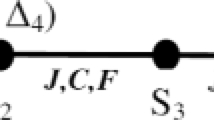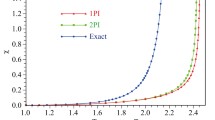Abstract
We have used the method of high-temperature series expansions to investigate the critical point properties of a continuous-spin Ising model and g0∶φ4∶d Euclidean field theory. We have computed through tenth order the hightemperature series expansions for the magnetization, susceptibility, second derivative of the susceptibility, and the second moment of the spin-spin correlation function on eight different lattices. Our analysis of these series is made using integral and Padé approximants. In three dimensions we find that hyperscaling fails for sufficiently Ising-like systems; the strong coupling limit of g0∶φ4∶3 depends on how the ultraviolet cutoff is removed. The level contours of the renormalized coupling constant for this model in theg 0, correlation-length plane exhibit a saddle point. If the ultraviolet cutoff is removed beforeg 0→ ∞, the usual field theory results and the renormalization-group fixed point with hyperscaling is obtained. If the order of these limits is reversed, the Ising model limit where hyperscaling fails and the field theory is trivial is obtained. In four dimensions, we find that hyperscaling fails completely; g0∶φ4∶4 is trivial for all g0 when the ultraviolet cutoff is removed.
Similar content being viewed by others
References
B. Widom,J. Chem. Phys. 43:3892, 3898 (1965); L. P. Kadanoff,Physics 2:263 (1966).
M. E. Fisher,Rep. Prog. Phys. 30:615 (1967).
G. Stell, inProceedings of the International School of Physics “Enrico Fermi,” Critical Phenomena, Course LI, M. S. Green, ed. (Academic, New York, 1971), p. 188, and references therein. See also G. Stell,Phys. Rev. B 5:981 (1972).
M. E. Fisher, inProceedings of the Twenty-Fourth Nobel Symposium on Collective Properties of Physical Systems, Aspenäsgården, Sweden, 1973, B. Lundquist and S. Lundquist, eds. (Academic, New York, 1973), p. 16.
L. P. Kadanoff, inProceedings of the International School of Physics “Enrico Fermi,” Critical Phenomena, Course LI, M. S. Green, ed. (Academic, New York, 1971), p. 100; L. P. Kadanoff, inPhase Transitions and Critical Phenomena, C. Domb and M. S. Green, eds. (Academic, New York, 1976), Vol. 5A, p. 1.
C. Domb, inPhase Transitions and Critical Phenomena, C. Domb and M. S. Green, eds. (Academic, New York, 1974), Vol. 3, p. 357.
L. P. Kadanoff,Phys. Rev. 188:859 (1969).
J. Stephenson,J. Math. Phys. 5:1009 (1964).
B. M. McCoy and T. T. Wu,The Two-dimensional Ising Model (Harvard University Press, Cambridge, Massachusetts, 1973), pp. 186–199.
B. M. McCoy, C. A. Tracy, and T. T. Wu,Phys. Rev. Lett. 38:793 (1977); B. M. McCoy and T. T. Wu,Phys. Rev. D 18:1243, 1253, 1259 (1978);Scientia Sinica XXII:1021 (1979).
G. A. Baker, Jr.,Phys. Rev. B 15:1552 (1977).
D. S. Gaunt and M. F. Sykes,J. Phys. A 12:L25 (1979); D. S. Gaunt, M. F. Sykes, and S. McKenzie,J. Phys. A 12:A871 (1979).
B. G. Nickel and B. Sharpe,J. Phys. A 12:1819 (1979).
J. J. Rehr,J. Phys. A 12:L179 (1979); J. Zinn-Justin,J. Phys. (Paris) 40:969 (1979); S. McKenzie,J. Phys. A 12:L185 (1979); J. W. Essam and M. E. Fisher,J. Chem. Phys. 38:802 (1963).
P. C. Hohenberg, inMicroscopic Structure and Dynamics of Liquids, J. Dupuy and A. J. Dianoux, eds. (Plenum, New York, 1979).
J. V. Sengers and J. M. H. Levelt Sengers, inProgress in Liquid Physics, C. A. Croxton, ed. (Wiley, Chichester, U.K., 1978), p. 103.
R. B. Griffiths,Phys. Rev. Lett. 24:715 (1970); J. M. Kincaid and E. G. D. Cohen,Phys. Rep. 22C:57 (1975).
K. G. Wilson and J. Kogut,Phys. Rep. 12C:75 (1974).
E. Brezin, J. C. LeGuillou, and J. Zinn-Justin, inPhase Transitions and Critical Phenomena, C. Domb and M. S. Green, eds. (Academic, New York, 1976), Vol. 6, p. 127.
K. Symanzik,J. Math. Phys. 7:510 (1966).
G. A. Baker, Jr.,J. Math. Phys. 16:1324 (1975).
M. A. Moore,Lett. Nuovo Cimento 3:275 (1972); C. DiCastro,Rev. Nuovo Cimento 1:199 (1971).
K. Symanzik, inLocal Quantum Field Theory, R. Jost, ed. (Academic, New York, 1969), p. 152.
J. D. Bjorken and S. D. Drell,Relativistic Quantum Fields (McGraw-Hill, New York, 1965).
N. N. Bogolubov and D. V. Shirkov,Introduction to the Theory of Quantized Fields (Interscience, New York, 1959).
T. H. Berlin and M. Kac,Phys. Rev. 86:821 (1952).
G. Caginalp, Theφ4 Lattice Field Theory as an Asymptotic Expansion about the Ising Limit, The Rockefeller University, preprint (1979); F. Constantinescu,Phys. Rev. Lett. 43:1632 (1979); C. M. Bender, F. Cooper, G. S. Garalnik, and D. Sharp,Phys. Rev. D 19:865 (1979).
J. Glimm and A. Jaffe, The Coupling Constant in a φ4 Field Theory, The Rockefeller University, preprint (1979).
W. Ford and G. E. Uhlenbeck, inStudies in Statistical Mechanics, J. de Boer, ed. (North-Holland, Amsterdam, 1962), Vol. 1, p. 119.
R. Schrader,Phys. Rev. B 14:172 (1976); G. A. Baker, Jr., and S. Krinsky,J. Math. Phys. 18:590 (1977).
R. Schrader,Commun. Math. Phys. 49:131 (1976);50:97 (1976);Ann. Inst. Henri Poincaré 26:295 (1977); R. Schrader and E. Tränkle, A Possible Constructive Approach toφ 44 IV, Free University of Berlin, preprint (1980).
G. A. Baker, Jr., B. G. Nickel, M. S. Green, and D. Meiron,Phys. Rev. Lett. 36:1351 (1976); G. A. Baker, Jr., B. G. Nickel, and D. Meiron,Phys. Rev. B 17:1365 (1978).
J. C. LeGuillou and J. Zinn-Justin,Phys. Rev. Lett. 39:95 (1977).
M. Wortis, inPhase Transitions and Critical Phenomena, C. Domb and M. S. Green, eds. (Academic, New York, 1974), Vol. 3, p. 114.
J. P. Van Dyke and W. J. Camp,Phys. Rev. Lett. 35:323 (1975); J. P. Van Dyke and W. J. Camp, inMagnetism and Magnetic Materials—1973 G. D. Graham, Jr., and J. J. Rhyne, eds., AIP Conference Proceedings No. 18 (American Institute of Physics, New York, 1974), p. 878.
A. D. Hall,Commun. ACM 14:517 (1971).
G. A. Baker, Jr., H. E. Gilbert, J. Eve, and G. S. Rushbrooke, Brookhaven National Laboratory Report No. BNL 50053 (1967).
M. F. Sykes, private communication.
C. Domb and B. R. Heap,Proc. Phys. Soc. 90:985 (1967).
J. M. Kincaid, G. A. Baker, Jr., and L. W. Fullerton, Los Alamos Scientific Laboratory Report No. LA-UR-79-1575 (1979).
C. Domb,Adv. Phys. 9:149, 245 (1960).
M. A. Moore,Phys. Rev. Lett. 23:861 (1969).
J. W. Essam and D. L. Hunter,J. Phys. C 1:392 (1968), and private communication.
R. K. Wehner and D. Baeriswyl,Physica 81A:129 (1975).
D. L. Hunter and G. A. Baker, Jr.,Phys. Rev. B 7:3346 (1973).
G. A. Baker, Jr. and D. L. Hunter,Phys. Rev. B 7:3377 (1973).
D. L. Hunter and G. A. Baker, Jr.,Phys. Rev. B 19:3808 (1979).
A. J. Guttman and G. S. Joyce,J. Phys. A 5:281 (1974); J. L. Gammel, inPadé Approximants and Their Applications, P. R. Graves-Morris, ed. (Academic, London, 1973); M. E. Fisher and H. Au-Yang,J. Phys. A 12:1677 (1979).
J. Glimm and A. Jaffe,Acta Phys. Austriaca Suppl. 16:147 (1976).
D. Isaacson,Commun. Pure Appl. Math. 29:531 (1976).
D. Marchesin, Ph.D. thesis, New York University (1975).
C. M. Bender, F. Cooper, G. S. Guralnik, R. Roskies, and D. Sharp, inProceedings of Orbis Scientiae 80, A. Perlmutter, ed. (1980), to be published.
J. P. Eckman, J. Magnen, and R. Sénéor,Commun. Math. Phys. 39:251 (1975); J. Dimock,Commun. Math. Phys. 35:347 (1974); J. Glimm, A. Jaffe, and T. Spencer, inConstructive Field Theory, G. Velo and A. Wightman, eds. (Springer, Berlin, 1973), p. 1.
J. M. H. Levelt Sengers, inProceedings of the Seventh Symposium on Thermophysical Properties, A. Cezairliyan, ed. (American Society of Mechanical Engineers, New York, 1977), p. 766.
J. Feldman and K. Osterwalder,Ann. Phys. (N.Y.) 97:80 (1976); J. Magnen and R. Sénéor,Ann. Inst. Henri Poincaré,24:95 (1976); J. Glimm and A. Jaffe,Fortschr. Phys. 21:327 (1973).
G. A. Baker, Jr.,Phys. Rev. Lett. 34:268 (1975); O. McBryan and J. Rosen,Commun. Math. Phys. 51:97 (1976).
Author information
Authors and Affiliations
Additional information
Work supported in part by the U.S. Department of Energy.
Rights and permissions
About this article
Cite this article
Baker, G.A., Kincaid, J.M. The continuous-spin Ising model, g0∶φ4∶d field theory, and the renormalization group. J Stat Phys 24, 469–528 (1981). https://doi.org/10.1007/BF01012818
Received:
Issue Date:
DOI: https://doi.org/10.1007/BF01012818




